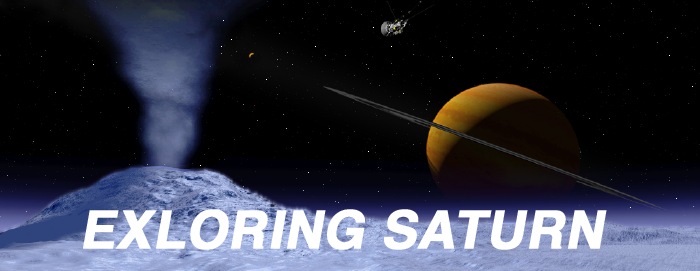 |
|||||||
| One of the Most Complex and Ambitious Ventures in the History of Space Exploration | |||||||
| Saturn | Rings | Moons | Titan | Cassini | Science | Huygens | Resources |
THE LATEST CASSINI NEWS FROM SATURN »»
SOME IMPORTANT CASSINI FINDINGS SO FAR »»
The best-equipped spacecraft Earth has ever sent to examine another planet, Cassini was launched in 1997 on a journey of 2.2 billion miles to Saturn. It is the most instrumented and scientifically-capable interplanetary probe ever flown.
The first color picture from the surface of Titan by Huygens on January 14, 2005.
The Cassini project is the result of the best technical efforts of 260 scientists from the United States and 17 European nations. OTHER INTERPLANETARY PROBES FROM EARTH »»
Tools. The international Cassini-Huygens mission is a complex four-year tour of Saturn, including the planet's majestic rings and 31 known moons. To do the job, the spacecraft are outfitted with 12 instruments on the Cassini orbiter and six on the Huygens probe.
The total of 18 sophisticated science instruments aboard the two spacecraft have and will send back data and images of Saturn's rings, icy satellites, magnetosphere, and Titan, the planet's largest moon.
Huygens. One of the most powerful scientific instruments carried to Saturn by Cassini was the Huygens landing probe, which itself carried half a dozen sensitive instruments to study the atmosphere and surface of Saturn's giant moon Titan.
After Huygens was released from Cassini to drop on Titan, a camera collected more than a thousand images of Titan's surface and clouds. Another instrument used radio signals to measure Titan's winds. Three sensors analyzed the moon's atmosphere. Huygens survived the landing to photograph and measure what it found on smoggy Titan's surface.
COULD CASSINI BE NASA'S LAST MEGA-MISSION? »»
The Tools
The Saturn orbiter carries:Cassini scientific instruments are:
- four instruments to "see" in three kinds of light,
- a system to create radar images,
- instruments for measuring dust particles, radio waves, and plasma waves,
- machines for measuring the magnetic fields in space and around Saturn, and
- instruments to measure particles near the spacecraft.
- Cassini Plasma Spectrometer that explores plasma within and near Saturn's magnetic field
- Composite Infrared Spectrometer that studies temperatures and compositions of Saturn and its moons and rings
- Cosmic Dust Analyzer that studies ice and dust grains in and near the Saturn system
- Dual Technique Magnetometer that studies Saturn's magnetic field and its interactions with the rings, the moons, and the solar wind
- Imaging Science Subsystem that takes pictures in visible, near-ultraviolet, and near-infrared light
- Ion and Neutral Mass Spectrometer that studies extended atmospheres and ionospheres of Saturn, Titan, and icy satellites
- Magnetospheric Imaging Instrument that takes pictures of the distribution of charged particles in and near Saturn's magnetic field
- Titan Radar that maps the surface of Titan and measures the height of its surface features
- Radio and Plasma Wave Science that investigates plasma waves, natural emissions of radio energy, and dust
- Radio Science Subsystem that searches for gravitational waves; measures masses and structures of atmospheres
- Ultraviolet Imaging Spectrograph that studies structure, chemistry, and composition of atmospheres and rings
- Visual and Infrared Mapping Spectrometer that identifies chemical composition of surfaces, atmospheres, and rings
- Huygens instruments
What Questions Will Cassini Try to Answer?
SaturnTitan
- What is the atmosphere like below the cloud tops?
- How do storms get started and die out?
- How are the polar regions different from areas near the equator?
- What is Saturn's interior like?
Rings
- What is the surface like?
- Are there lakes, oceans, or rivers?
- Does it rain?
- In what direction do winds blow?
- How much sunlight reaches the surface?
- Could life ever exist there?
Icy Satellites
- What, besides particles of ice, makes up the rings?
- What are the sizes of the particles?
- How do the rings form and change?
- Are there more moons hidden in the rings?
Magnetosphere
- What is the past history of these moons?
- Is Phoebe a captured asteroid?
- Why is Iapetus' surface half dark and half bright?
- Why do some moons have the same orbits?
Cassini is expected to send 300,000 color pictures by radio to Earth, including 1,100 of the largest moon, Titan. Astronomers hope the images will reveal whether Titan has methane lakes.
- What kinds of particles are trapped there?
- Do they change with time?
- How do they affect the rings and moons?
- What does the magnetosphere tell us about the inside of Saturn?
Back in 1980 and 1981, the Voyager probes 1 and 2 from Earth flew by Saturn and transmitted more than 30,000 images of the planet to Earth. Unlike the Voyager probes, which were designed to fly by several planets, Cassini is dedicted to research in the vicinity of Saturn.
The Operators
Cassini-Huygens is a project of NASA, the European Space Agency and the Italian Space Agency. NASA's Jet Propulsion Laboratory (JPL), a division of the California Institute of Technology at Pasadena, manages the mission for NASA's Office of Space Science, Washington, D.C. The Cassini orbiter and its two onboard cameras were built at JPL. Huygens was built by the European Space Agency. The imaging team is based at the Space Science Institute, Boulder, Colorado.
| Top of this page | Saturn main page | The Planet | The Rings | The Moons | Solar System |
| Cassini probe | Cassini Science | Titan moon | Huygens | Internet Resources | |
| STO Cover | Search STO | Questions | Copyright 2005 Space Today Online | ||
